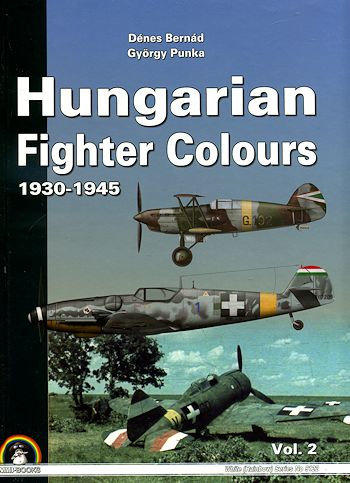MMP Books' Hungarian Fighter Colors vol 2
|
Author: |
Dénes Bernád &
György Punka |
|
Publisher |
Mushroom Models
Publications |
|
Price |
$69.00 SRP from
Casemate Publishing |
|
Reviewer: |
Scott Van Aken
|
|
Notes: |
#9119
ISBN 978-83-63678-21-0
176 pages, hardbound, 8x12 inches |
 What with all the concentration on camouflage and colors for the major powers,
it is often that some of the other participants in WWII get overlooked. Such is
the case for the Hungarian air force. Like Germany, Hungary was severely limited
in what they could put in the air and a national air force was strictly
forbidden. Unlike Germany, it took the nation quite a while to finally declare a
national air arm and that was in 1938.
What with all the concentration on camouflage and colors for the major powers,
it is often that some of the other participants in WWII get overlooked. Such is
the case for the Hungarian air force. Like Germany, Hungary was severely limited
in what they could put in the air and a national air force was strictly
forbidden. Unlike Germany, it took the nation quite a while to finally declare a
national air arm and that was in 1938.
From there the air arm grew, both as a result
of purchasing aircraft from overseas and by building up an indigenous aircraft
industry. As is frequently the case, those airplanes bought from overseas
sellers were not the top of the line for the most part. The seller nations had
their own requirements to meet before being able to provide to others. Even when
newer equipment entered service, it was not infrequent that the airframes would
have some miles on them and would need some refurbishment prior to use.
This volume continues from the excellent first
one and covers the following types: He-112, Avia B.534, PZL P.11a,
Re-2000, Weiss-Manfred WM-23, a variety of Bf-109G versions, the locally built
Me-210Ca, the Bf-110F/G and the FW-190A/F/G.
Some of the aircraft were available in very
small numbers, sometime as few as a single example. The Hungarians built their
own version of the Re.2000, some with Italian engines and some with locally
built WM-14, 14 cylinder engines, giving the aircraft a rather interesting look.
The Me-210 was also built locally, incorporating many Me-410 features, such as
the lengthened fuselage. These aircraft performed as poorly as fighters as did
their German counterparts. The 109G was also built locally with a portion of the
production going to the Luftwaffe. These were primarily G-4, G-6 and G-14
variants. Those FW-190s used by the Hungarian Air Force were mostly late war
fighter bomber version. In this case, the 190 units did not see all that much
combat as they were only operational in the last months of the war. By that
time, the Soviet Army was moving so quickly that bases were quickly over-run and
the lack of fuel pretty much brought things to a slow crawl at best.
Each section not only gives a rundown
on the types service but also we are treated to a great selection of period
photos, a few of them in color. This is further enhanced by a large number of
full color profiles based on some of the photos that are in each section.
This is all followed up with several
appendices that include a fascinating look at how the artist is able to provide
an accurate color profile of various types, a procedure that is a lot more
involved than I would have thought. This is then followed by a listing of aces.
In actuality, this lists pretty much every Hungarian pilot that had a confirmed
or even a claimed victory for which no additional eye witness was available. In
this section are a number of photos of the planes that were shot down. It
is superbly researched, just like the rest of the book. Like the initial volume, it is an outstanding book that is well researched, provides us with a
bevy of interesting photos and is just the perfect book for the modeler and
enthusiast alike. These two volumes are sure to be the standard on the subject
for quite some time to come. Highly recommended.
April 2014
Review book courtesy of
Casemate Publishing where
you can get yours.
If you would like your product reviewed fairly and fairly quickly, please contact
me or see other details in the Note to
Contributors.
 What with all the concentration on camouflage and colors for the major powers,
it is often that some of the other participants in WWII get overlooked. Such is
the case for the Hungarian air force. Like Germany, Hungary was severely limited
in what they could put in the air and a national air force was strictly
forbidden. Unlike Germany, it took the nation quite a while to finally declare a
national air arm and that was in 1938.
What with all the concentration on camouflage and colors for the major powers,
it is often that some of the other participants in WWII get overlooked. Such is
the case for the Hungarian air force. Like Germany, Hungary was severely limited
in what they could put in the air and a national air force was strictly
forbidden. Unlike Germany, it took the nation quite a while to finally declare a
national air arm and that was in 1938.